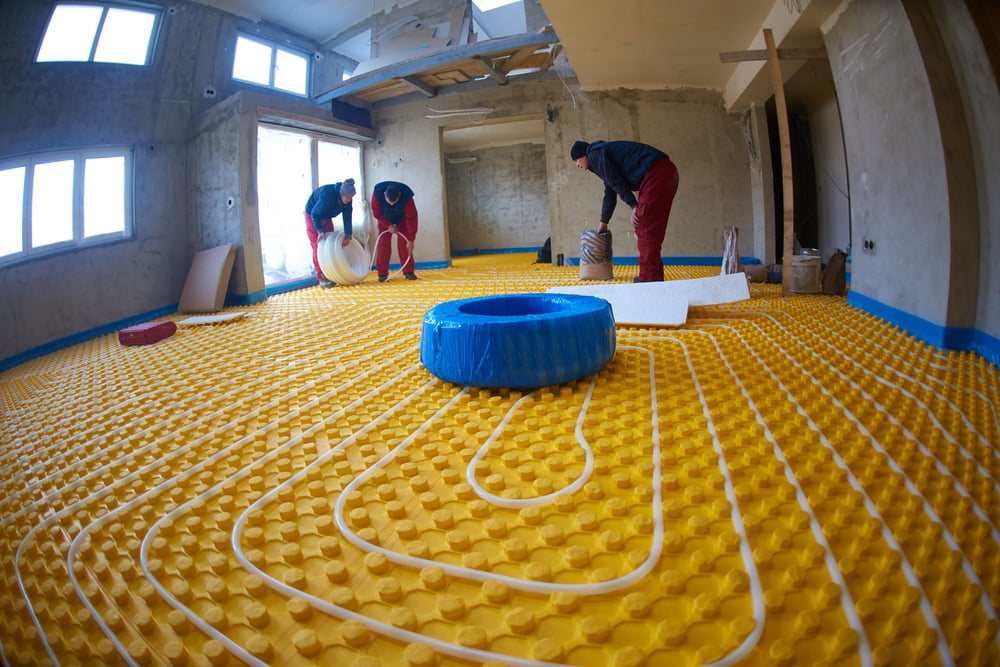Why use underfloor heating instead of radiators?
Compared to radiators, underfloor heating is a more subtle and less obtrusive solution when it comes to heating your home. More often than not, radiators are big and bulky and can therefore disrupt the overall look of any given room or space.
Underfloor heating also offers improved thermal comfort compared to conventional heating methods. Radiators, for example, use room air to transfer heat, resulting in uneven warmth and higher temperatures at ceiling height compared to floor level. With underfloor heating, the floor is gently heated by piped warm water and the heating energy is evenly emitted from the floor by natural radiation.
Likewise, the process of heat radiation helps to create a healthier living environment for occupants. The warm floor inhibits the growth of fungi and dust mites meaning fewer dust circulates in the air while maintaining an even distribution of heat.
Is underfloor heating expensive?
Although there is an increased up-front cost of underfloor heating, it can be a more cost-effective solution in some applications. As the temperature required is lower than that of conventional heating, you could see your energy bills decrease by up to 20%. Where low-surface temperature radiators are required, which are considerably more expensive than standard radiators, underfloor heating would be a cheaper option.
What are the challenges of installing underfloor heating?
The ease of installation of underfloor heating will very much depend on what lies beneath the floorboards or carpet. For example, if a property has an old, joisted floor, installing an underfloor heating system in between existing panels can be a challenge and it is likely that the new panels will need to be cut to size. Depending on when it was built, the property may also already feature a screed in which all pipework is buried, posing further challenges.
Is it complicated and time-consuming to install underfloor heating in a renovation? Do floor heights have to be increased?
In most instances the existing flooring will need to be lifted to increase its insulation value and, as such, it isn’t necessarily more complicated or time-consuming to install underfloor heating as part of a renovation. You can simplify the process by overlaying a system directly on top of the existing floor, but you may need to alter door heights and lift skirting boards to accommodate this. Safety is a key consideration here, especially if adjusting floor heights by stairs as this can change step heights and potentially cause a trip hazard for residents.

How can underfloor heating be installed more quickly?
Underfloor heating can often be less labour intensive to fit and therefore quicker than conventional heating methods. Fitting an entire underfloor heating installation, complete with pipework and manifold, could take up to one day. Boiler connections and electrical works are then required to complete the job.
If you’re installing underfloor heating as part of a floating floor where there is little height build-up, the process can be very time efficient. Panels can be laid directly on top of the existing floor and the conductor pipes and plates are simply walked into pre-cut groves.
Is it possible to lay floor tiles directly over underfloor heating?
Tiles can often be laid directly over an underfloor heating system. If a screed has been installed then laying tiles above the system is an easy option, so long as the surface is level and flat.
Are lightweight systems strong enough to last? What if there's a leak?
Hep2O underfloor heating systems are made from high-quality insulation boards specifically manufactured to last for the entire lifecycle of your home. These boards have a high compression value and are capable of withstanding years of footfall from residents. In the instance of a leak, an easy-to-install Hep2O push-fit fitting can rectify it.
What guarantees are available on systems?
All Hep2O underfloor heating products are manufactured under a quality management system which is approved to BS EN ISO 9001:2008. The heating and cooling pipe and the Hep2O push-fit fitting are guaranteed for 100 years and 50 years respectively.